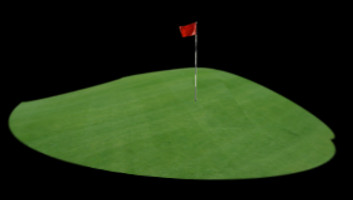
Flag (aka Flagstick, Pin)
In golf, the term flag, also known as flagstick or pin, refers to a marker positioned at the hole on a golf green. It is an essential part of the game, as it assists golfers in determining the location of the hole from a distance.
- Visual Marker: The flag functions as a visual marker, enabling players to easily identify the position of the hole on the putting green. Without the flag, it would be challenging for golfers to determine the exact location they need to aim for.
- Height: The flagstick is typically about 7 to 8 feet tall. Its height allows it to be seen from a distance, including from the fairway or tee box, helping golfers plan their shots accordingly.
- Construction: The flag typically consists of a colored cloth or nylon material attached to a long pole. The cloth usually features patterns or designs unique to the golf course, often displaying the club logo or colors to create a distinct visual identifier.
- Removable: The flag is removable, meaning that it can be taken out of the hole when putting. Players have the option to either putt with the flagstick in place or remove it according to their preferences. However, it is essential to note that different golf courses have specific rules regarding whether the flag must be left in or removed during play.
- Functionality: The flag serves two main purposes during a round of golf:
- 1. Visibility: As previously mentioned, the flag is highly visible and helps golfers determine the exact location of the hole, especially from a distance.
- 2. Guidance: When a golfer is putting on the green, the flag provides an aiming point. By aligning the ball's path with the flagstick, players can have a visual reference to help improve their accuracy and aim towards the hole.
- Cautions: While the flag is a helpful feature on the golf course, there are a few important cautions to be aware of:
- i. Removing the Flag: When removing the flagstick from the hole, it is crucial to handle it with care. Avoid dropping or causing any damage to the green or the flag itself.
- ii. Etiquette: It is considered proper golf etiquette to avoid unnecessary contact with the flagstick. When retrieving the ball from the hole, players should try to prevent the flag from hitting the edge, potentially causing damage to the hole or the pin.
- iii. Wind: On windy days, leaving the flag in place can help determine the wind direction and intensity. Observing the flag can provide valuable information when selecting the appropriate club and planning shots.
Overall, the flag or flagstick is an integral part of a golf course, guiding players towards the holes and assisting with accurate putting. By considering the guidelines and etiquettes associated with the flag, golfers can optimize their playing experience while maintaining the integrity of the course.





